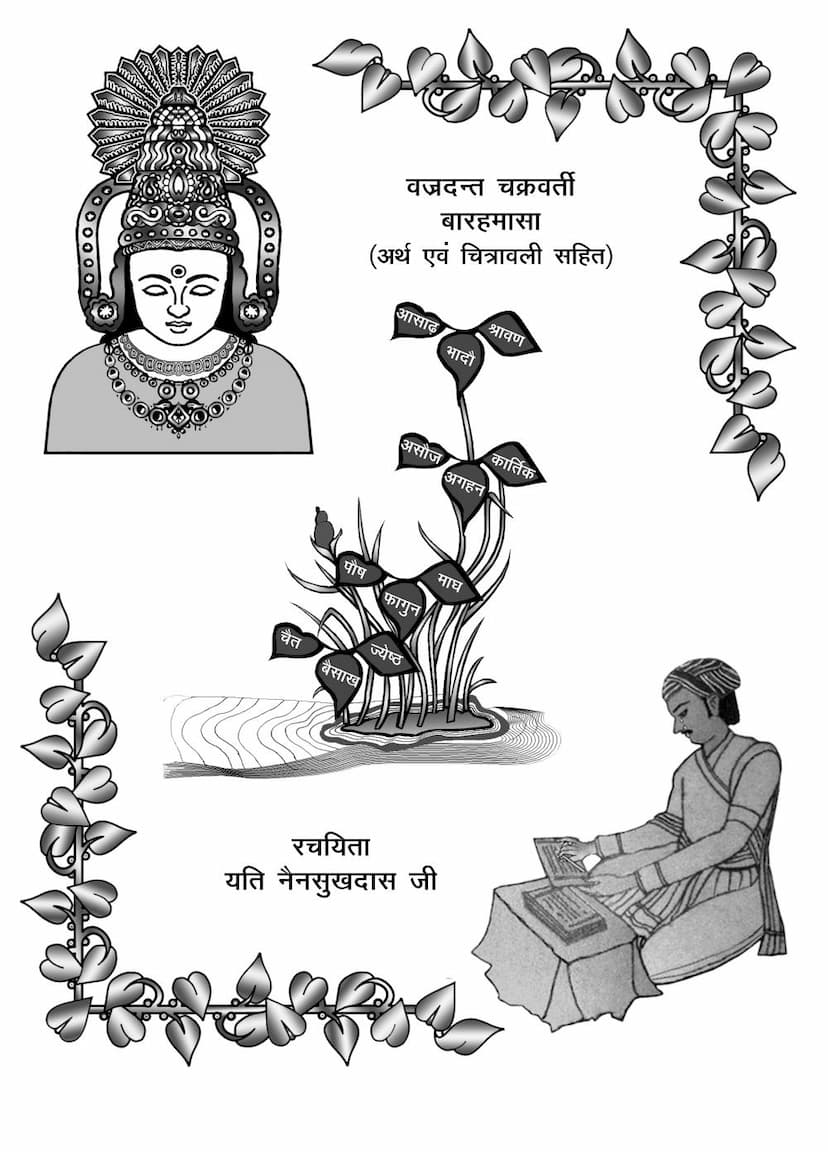Vajradant Chakravarti Barahmasa
Added to library: September 2, 2025

Summary
The Jain text "Vajradant Chakravarti Barahmasa" (The Twelve Months of Emperor Vajradant) authored by Yati Nainsukhdas Ji, with editing by Kundalata Jain and Abha Jain, is a profound spiritual narrative presented in a poetic and illustrative format. The book, published by Kundalata and Abha Jain, aims to inspire detachment from worldly pleasures and guide individuals towards the path of Jain spiritual liberation.
The core of the text is the story of Emperor Vajradant, a righteous and prosperous ruler who, despite possessing immense wealth, power, and a vast empire with 32,000 subordinate kings, 96,000 queens, and 1,000 sons, experiences a profound spiritual awakening. This awakening is triggered by observing a bumblebee trapped in a lotus, symbolizing how attachment to sensory pleasures, even a single one, can lead to a spiritual demise. This observation instills in him a deep sense of vairagya (detachment) and the desire to embrace Jain spiritual initiation (diksha).
The "Barahmasa" (Twelve Months) narrative unfolds as a dialogue between Emperor Vajradant and his sons. Starting from the month of Ashadh (June-July), the emperor attempts to persuade his sons to inherit the kingdom and take on the responsibilities of governance. He describes the hardships and difficulties associated with the ascetic life, the renunciation of worldly possessions, and the challenges of adhering to Jain monastic vows. He presents the political necessities and the ancestral customs of his dynasty as reasons for his sons to continue the royal lineage.
However, the emperor's thousand sons, who are described as virtuous and spiritually inclined, are equally inspired by their father's awakening. They reject his offers of kingship, stating that they cannot accept what he, their father, considers a source of suffering and attachment. They express their firm resolve to follow their father and embrace the five great vows of Jainism.
Each month's discourse highlights the father's attempts to dissuade his sons and the sons' unwavering commitment to their spiritual path. The sons counter their father's arguments by reflecting on the intense suffering experienced in the four realms of existence (hells, animals, humans, and heavens), the futility of worldly enjoyments, and their own spiritual insights gained through introspection and observing the plight of the bumblebee.
The narrative continues through the twelve months, with the sons consistently demonstrating their renunciation and spiritual determination. By the eleventh month, Vaishakh (April-May), the emperor recognizes the futility of further persuasion and agrees to their wishes. He arranges for his six-month-old grandson to be crowned king, symbolizing the transition of worldly power.
Following this, Emperor Vajradant, along with 30,000 of the subordinate kings, his 1,000 sons, and 60,000 queens, renounces the world and embarks on the path of Jain diksha. They publicly declare their renunciation and seek forgiveness from all living beings, embracing the teachings of the Arhats, Siddhas, and Sadhus. They perform the act of keśaloñch (plucking out hair) as a symbol of their complete detachment.
The narrative concludes with the spiritual attainment of the spiritual preceptor, Pihitasrav, who attains Kevalgyan (omniscience) through intense ascetic practices in the month of Jyeshtha (May-June). Emperor Vajradant and all those who renounced the world also achieve liberation (moksha) through their diligent practice and attainment of the three jewels (Samyak Darshan, Samyak Gyan, and Samyak Charitra). The text emphasizes that anyone who reads and contemplates this "Barahmasa" will overcome obstacles and attain spiritual merits and happiness, ultimately leading to liberation.
The book also includes a section of "Shraddha Sumannarpan" (offering of floral tributes) and an "Atma Sambodhan" (self-address), likely devotional or introspective pieces. The "Aamukh" (foreword) mentions that the book is dedicated to the memory of Smt. Premlata Ji Jain and highlights the efforts of the editors in bringing out this illustrated edition, acknowledging the contributions of various individuals and organizations. The "Barahmasa ka Saar" (essence of Barahmasa) provides a summary of the story and the poet's intention. The "Barahmasa Samvad" (dialogue of Barahmasa) presents the detailed monthly conversations, and the "Barahmasa Chitranavali" (illustrated sequence of Barahmasa) visually complements the narrative, depicting key events and concepts.
In essence, "Vajradant Chakravarti Barahmasa" serves as a powerful didactic work, illustrating the Jain principles of renunciation, detachment from worldly attachments, the arduous yet ultimately rewarding path of asceticism, and the attainment of eternal happiness through spiritual realization.